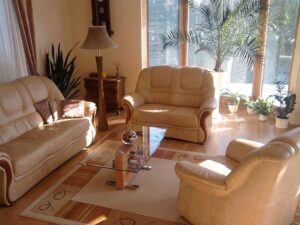Introduction
Furniture board is a versatile material commonly used in the construction of furniture. It offers various benefits such as durability, affordability, and ease of customization. In this article, we will delve deeper into the topic of furniture board, exploring its composition, manufacturing process, uses, and advantages.
Composition
Furniture board, also known as particle board or chipboard, is made from wood particles or fibers that are bonded together using a synthetic resin or adhesive. These wood particles are typically obtained from sawmill residues, such as wood chips, shavings, and sawdust, which are then compressed and bound with the resin.
The composition of furniture board can vary depending on the desired strength and quality. It may include different types of wood fibers, such as hardwood or softwood, as well as additives like wax or fire retardants to enhance specific properties.
Manufacturing Process
The manufacturing process of furniture board involves several steps. First, the wood particles are dried to reduce moisture content, which helps in achieving better bonding. Then, they are mixed with the resin and other additives in a specific ratio. This mixture is then spread onto a flat surface, forming a mat.
Next, the mat is subjected to high pressure and temperature in a hydraulic press. The pressure and heat cause the resin to cure and bond the wood particles together. After the curing process, the board is trimmed, sanded, and cut into desired sizes.
Uses
Furniture board finds extensive use in the furniture industry due to its affordability and versatility. It is commonly used as a core material for various types of furniture, including cabinets, shelves, tables, and bookcases. The smooth surface of furniture board makes it ideal for applying laminates, veneers, or paints to achieve different finishes and aesthetics.
In addition to furniture, furniture board is also used in interior construction, such as wall paneling, partitions, and flooring underlayment. Its dimensional stability and uniformity make it a suitable choice for these applications.
Advantages
Durability: Furniture board is known for its durability and strength. The bonding process ensures that the wood particles are tightly held together, making the board resistant to warping, cracking, and splitting. It can withstand heavy loads and is less prone to damage compared to solid wood.
Affordability: One of the significant advantages of furniture board is its affordability. It is a cost-effective alternative to solid wood, allowing consumers to achieve a similar look and functionality at a lower price point.
Customization: Furniture board offers excellent customization options. Its smooth surface allows for easy application of laminates, veneers, or paints, enabling individuals to personalize their furniture according to their preferences. It also provides flexibility in terms of size and shape, making it suitable for various design requirements.
Conclusion
Furniture board is a versatile and cost-effective material used in the construction of furniture and interior applications. Its composition, manufacturing process, and advantages make it a popular choice in the industry. With its durability, affordability, and customization options, furniture board offers a practical solution for those seeking quality furniture without breaking the bank.
References
– Furniture Board: https://www.woodworkingnetwork.com/glossary/furniture-board
– Particle Board: https://www.britannica.com/technology/particle-board
– Understanding Furniture Board: https://www.cabinetjoint.com/understanding-furniture-board/













